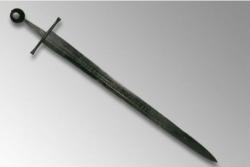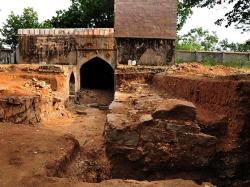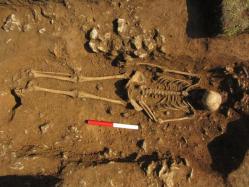INSTITUT SUPERIEUR D'ANTHROPOLOGIE
INSTITUTE OF ANTHROPOLOGY
ONLINE COURSES / COURS A DISTANCE
FALL TERM : OCTOBER 2015
REGISTER NOW
ROYAUME UNI – 
 River Witham - A medieval sword linked to the Magna Carta is causing a bit of a mystery for historians at the British Library. Researchers are appealing for help to deceiver the inscription on the sword which was found in the River Witham in July 1825. According to a blog by curator Julian Harrison the sword was presented to the Royal Archaeological Institute by the registrar to the Bishop of Lincoln. Mr Harrison says in his blog: "An intriguing feature of this sword is an as yet indecipherable inscription, found along one of its edges and inlaid in gold wire. "It has been speculated that this is a religious invocation, since the language is unknown." The inscription seems to read +NDXOXCHWDRGHDXORVI+ . The sword weighs 1.2 kg (2lb 10oz) and measures 964mm (38in) in length and 165mm (6.5in) across the hilt.Marc van Hasselt from Utrecht University, Hastatus Heritage Consultancy, posted on the blog that the River Witham sword could be part of a large international family as inscribed swords were all the rage in Europe around the year 1200. He said: "While researching a specific sword-blade found in Alphen aan den Rijn, the Netherlands, I found around a dozen other swords which had striking similarities. "The swords themselves are of a high quality, but what most catches the eye are the inscriptions. Both their mysterious contents and the similarities in the lettering are striking. A sword from Sweden might use the same slightly curved X as the River Witham sword. A sword currently in Berlin has an I-S contraction also used on a sword found in the Netherlands. "These similarities go so far as to suggest the same hand in making the inscriptions. However, their contents are still a mystery, regardless of their origins." He goes on to suggest a saint is being invoked on the River Witham sword in Latin. He suggests the start of the River Witham inscription, ND, could be Nostrum Dominus (our Lord) or Nomine Dominin (name of the Lord) followed by XOX referring to the Holy Trinity. He says in the blog: "By putting together pieces of the puzzle from all over Europe, we might come a little bit closer to solving the mystery. And even if we cannot decipher the inscriptions completely, they might bring us a little closer to understanding our ancestors."
River Witham - A medieval sword linked to the Magna Carta is causing a bit of a mystery for historians at the British Library. Researchers are appealing for help to deceiver the inscription on the sword which was found in the River Witham in July 1825. According to a blog by curator Julian Harrison the sword was presented to the Royal Archaeological Institute by the registrar to the Bishop of Lincoln. Mr Harrison says in his blog: "An intriguing feature of this sword is an as yet indecipherable inscription, found along one of its edges and inlaid in gold wire. "It has been speculated that this is a religious invocation, since the language is unknown." The inscription seems to read +NDXOXCHWDRGHDXORVI+ . The sword weighs 1.2 kg (2lb 10oz) and measures 964mm (38in) in length and 165mm (6.5in) across the hilt.Marc van Hasselt from Utrecht University, Hastatus Heritage Consultancy, posted on the blog that the River Witham sword could be part of a large international family as inscribed swords were all the rage in Europe around the year 1200. He said: "While researching a specific sword-blade found in Alphen aan den Rijn, the Netherlands, I found around a dozen other swords which had striking similarities. "The swords themselves are of a high quality, but what most catches the eye are the inscriptions. Both their mysterious contents and the similarities in the lettering are striking. A sword from Sweden might use the same slightly curved X as the River Witham sword. A sword currently in Berlin has an I-S contraction also used on a sword found in the Netherlands. "These similarities go so far as to suggest the same hand in making the inscriptions. However, their contents are still a mystery, regardless of their origins." He goes on to suggest a saint is being invoked on the River Witham sword in Latin. He suggests the start of the River Witham inscription, ND, could be Nostrum Dominus (our Lord) or Nomine Dominin (name of the Lord) followed by XOX referring to the Holy Trinity. He says in the blog: "By putting together pieces of the puzzle from all over Europe, we might come a little bit closer to solving the mystery. And even if we cannot decipher the inscriptions completely, they might bring us a little closer to understanding our ancestors."
http://www.lincolnshireecho.co.uk/Mystery-surrounds-inscription-Magna-Carta-sword/story-27569636-detail/story.html?#1
INDE –  Qutub Shahi - In a significant discovery, archaeologists on Friday said they have unearthed artifacts from a 16th century 'Summer Palace' in the Qutub Shahi Tombs complex. The nature of the findings revealed that the sultans had close trade relations with China. The 'Summer Palace', in the southwest portion of the royal necropolis, now adds to the city's treasure trove of heritage structures. Aga Khan Trust for Culture (AKTC) project archaeological director K K Muhammed announced they found Chinese pottery dated 16th century. "This shows that there were trade relations between the Qutub Shahi Sultanate and China. We have also found hookahs," he said at a media interaction jointly hosted by the Trust and the US Consulate-General. Hookahs were introduced in India by the Portuguese in 1604 and it is likely that those found at the excavation site belong to the same time period, he said. The archaeological find could have been constructed during the same time period, he added. "Martabani pottery was also found. Martabaniware's roots can be traced to Southeast Asia -- to places like Malaysia, Java and Sumatra," he added. The senior archaeologist clarified that the name 'Summer Palace' could be a misnomer as the structure served as an accommodation block for "hundreds of people" working at the tombs complex. Many of them were engaged in Qurankhwani -- arranging group recitations of Quran. Around 28 dorms, measuring roughly 20 feet by 10 feet each, are a part of this block. "There was a muallim (teacher) with 20 to 25 students. A portion which has a mosque has also been found," he said. The recently discovered structure has underground chambers that "have a cooling effect" -- which is why it may have been given the name, the expert said. Cisterns and aqueducts were a part of the structure too. When compared to other parts of the tombs complex, the southwest portion showed more promise and potential, according to the senior archaeologist. "The earth in the area has not been disturbed unlike in other parts of this place. This is an archaeologists dream," he said. Other experts said that the pottery, blue and white in colour, has decipherable Chinese inscriptions. A source explained, ""Ta", meaning great, and "Ming", referring to the Ming dynasty from the Far East, are legible. "This buttresses the theory of a Chinese connection with Qutub Shahis of the Deccan," an expert said.
Qutub Shahi - In a significant discovery, archaeologists on Friday said they have unearthed artifacts from a 16th century 'Summer Palace' in the Qutub Shahi Tombs complex. The nature of the findings revealed that the sultans had close trade relations with China. The 'Summer Palace', in the southwest portion of the royal necropolis, now adds to the city's treasure trove of heritage structures. Aga Khan Trust for Culture (AKTC) project archaeological director K K Muhammed announced they found Chinese pottery dated 16th century. "This shows that there were trade relations between the Qutub Shahi Sultanate and China. We have also found hookahs," he said at a media interaction jointly hosted by the Trust and the US Consulate-General. Hookahs were introduced in India by the Portuguese in 1604 and it is likely that those found at the excavation site belong to the same time period, he said. The archaeological find could have been constructed during the same time period, he added. "Martabani pottery was also found. Martabaniware's roots can be traced to Southeast Asia -- to places like Malaysia, Java and Sumatra," he added. The senior archaeologist clarified that the name 'Summer Palace' could be a misnomer as the structure served as an accommodation block for "hundreds of people" working at the tombs complex. Many of them were engaged in Qurankhwani -- arranging group recitations of Quran. Around 28 dorms, measuring roughly 20 feet by 10 feet each, are a part of this block. "There was a muallim (teacher) with 20 to 25 students. A portion which has a mosque has also been found," he said. The recently discovered structure has underground chambers that "have a cooling effect" -- which is why it may have been given the name, the expert said. Cisterns and aqueducts were a part of the structure too. When compared to other parts of the tombs complex, the southwest portion showed more promise and potential, according to the senior archaeologist. "The earth in the area has not been disturbed unlike in other parts of this place. This is an archaeologists dream," he said. Other experts said that the pottery, blue and white in colour, has decipherable Chinese inscriptions. A source explained, ""Ta", meaning great, and "Ming", referring to the Ming dynasty from the Far East, are legible. "This buttresses the theory of a Chinese connection with Qutub Shahis of the Deccan," an expert said.
http://timesofindia.indiatimes.com/india/Summer-Palace-at-Qutub-Shahi-has-a-chinese-connect/articleshow/48398821.cms
ROYAUME UNI –  Rollright Stones - EXPERTS from Oxford have been called in to investigate the “significant” discovery of a Saxon woman’s 1,400-year-old remains near the Rollright Stones. The young woman’s skeleton – dubbed ‘Rita of Rollright’ by archaeologists – was found close to the Neolithic and Bronze Age monuments, near Chipping Norton, with smaller items including a bronze ladle and an amethyst mounted in silver. They were discovered by amateur metal detectorists of the Muddy Boots Metal Detector Club and have been sent to the British Museum in London for detailed study. Anni Byard, finds liaison officer for Oxfordshire County Council, said she was called to the site at the end of March and on Easter Monday (April 6) a two-day excavation started to recover the 7th Century remains. Yesterday she said: “It is a very significant and interesting find. “This is the kind of burial that does not come up very often and is equally, if not more, important as the find in West Hanney. “The goods she was buried with are quite rare and as far as we know a bronze Saxon Patera (ladle) that was found may be only the fifth of its kind recorded.” Ms Byard added that the area the remains were found was considered important by the Saxons, largely because of the presence of the Rollright Stones. Theories being considered include that the woman held some kind of ceremonial position.
Rollright Stones - EXPERTS from Oxford have been called in to investigate the “significant” discovery of a Saxon woman’s 1,400-year-old remains near the Rollright Stones. The young woman’s skeleton – dubbed ‘Rita of Rollright’ by archaeologists – was found close to the Neolithic and Bronze Age monuments, near Chipping Norton, with smaller items including a bronze ladle and an amethyst mounted in silver. They were discovered by amateur metal detectorists of the Muddy Boots Metal Detector Club and have been sent to the British Museum in London for detailed study. Anni Byard, finds liaison officer for Oxfordshire County Council, said she was called to the site at the end of March and on Easter Monday (April 6) a two-day excavation started to recover the 7th Century remains. Yesterday she said: “It is a very significant and interesting find. “This is the kind of burial that does not come up very often and is equally, if not more, important as the find in West Hanney. “The goods she was buried with are quite rare and as far as we know a bronze Saxon Patera (ladle) that was found may be only the fifth of its kind recorded.” Ms Byard added that the area the remains were found was considered important by the Saxons, largely because of the presence of the Rollright Stones. Theories being considered include that the woman held some kind of ceremonial position.
http://www.oxfordmail.co.uk/news/13582588.Experts_investigate_discovery_of_1_400_year_old_Rita_of_Rollright/
IRLANDE - Millmount - The quest for what may lie buried beneath the great mound at Millmount took a step closer to its conclusion last week as geophysicist Kevin Barton returned to Drogheda to undertake the last of three geophysical surveys at the site in the courtyard of the Drogheda Museum complex at Millmount. This latest survey technique, known as Seismic Refraction Tomography (SRT) and involved placing geophones around the mound that would be able to detect sensitive signals from within by a hammer striking a plate on the mound.
http://www.independent.ie/regionals/droghedaindependent/news/searching-for-the-secrets-of-millmounts-mound-31431253.html
USA – Purrysburg - A crucial snapshot of South Carolina’s American Revolutionary War history is being clarified thanks to a study by Lowcountry archeologists. The LAMAR Institute has finished conducting an extensive field work study of the Battle of Purrysburg battlegrounds, located a few miles outside Hardeeville, and is about 90 percent done with lab analysis. The work began in January. After finding more than 100 musket balls, several canister shots and many explosive shells, Elliott said, the institute feels it has an accurate idea of where fighting took place more than 230 years ago. The Battle of Purrysburg occurred April 29, 1779, and was essentially a British victory, but not without a one-year delay by the Americans.
http://www.blufftontoday.com/bluffton-news/2015-08-09/archaeologists-uncover-new-details-battle-purrysburg-site#.VceBod-c08o